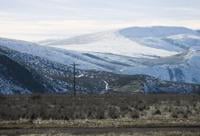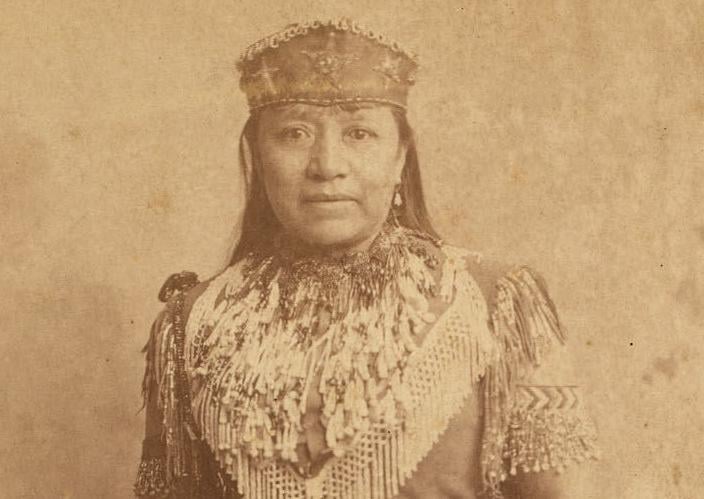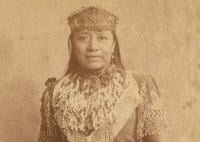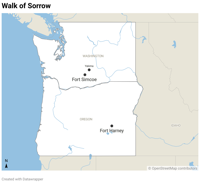In August 1975, a building burned down at Fort Simcoe Historical State Park.
A photo published in the Yakima Herald-Republic from that time shows charred rubble in the foreground, with the park's reconstructed guardhouse in the background. Blackened debris was all that remained of a two-story wood frame residence known as the Paiute House.
It wasn't open to the public and stood in a restricted area, Steve Adler reported in a front-page story about the blaze. A discarded cigarette likely caused the fire.
The building was used as a residence by Sarah Winnemucca, Adler wrote. Winnemucca was a leader of more than 500 Northern Paiute people — many of whom were elders, children and women.
The group was forced to move from Camp Harney in eastern Oregon to Fort Simcoe in 1879 after the Bannock War of 1878.
As attention grows on the history at Fort Simcoe and the Indian boarding school there that closed in the early 1920s, the story of the Northern Paiute also deserves more notice.
The journey
Two women gave birth during the approximately 350-mile journey from their homelands through rough country in snow that was feet deep in places. Both mothers and babies died. So did at least one elderly man and several children.
Another man died soon after they descended Toppenish Ridge and stayed briefly on land that today is part of the Toppenish National Wildlife Refuge. More died after they traveled to Fort Simcoe, where some lived in the area for more than five years until they were allowed to return to their homelands.
Winnemucca chronicled their forced march and life on the Yakima Reservation in her book, "Life Among the Piutes: Their Wrongs and Claims." Published in 1883, it is the first known autobiography written by a Native American woman, according to a biography of Winnemucca in the University of Minnesota's "Voices from the Gaps" collection.
She learned "just a little before Christmas" of 1878 that President Rutherford B. Hayes ordered her people be taken to the Yakama Reservation by military escort, Winnemucca wrote. "My people were only given one week to get ready in," she recalled.
Winnemucca was told not to say anything until three days before starting, she wrote. She responded to the news with disbelief and horror.
"I said, 'What! In this cold winter and in all this snow, and my people have so many little children? Why, they will all die. Oh, what can the President be thinking about? Oh, tell me, what is he? Is he man or beast? Yes, he must be a beast; if he has no feeling for my people, surely he ought to have some for the soldiers.'
"'I have never seen a president in my life and I want to know whether he is made of wood or rock, for I cannot for once think that he can be a human being. No human being would do such a thing as that — send people across a fearful mountain in midwinter.'"

The location where the Paiute House used to be at Fort Simcoe is pictured Saturday, March 23, 2024.
Descendants remember
The story of the forced march of the Wadatika Band of Northern Paiutes is shared on the official website of the Burns Paiute Tribe, which is primarily comprised of their descendants. The Burns Paiute Reservation is in rural eastern Oregon. The traditional homelands of the Burns Paiute include 5,250 square miles of land in central-southeastern Oregon, northern Nevada, northwestern California and western Idaho.
"An uprising to the east, the Bannock War, came to our homeland and when our people abandoned the Malheur Reservation to escape further conflict, a heavy price was paid," according to information on the tribe's website.
The Bannock War began in the early summer of 1878 with the encroachment of European settlers onto land that Bannock Indians lived on near Fort Hall in southeastern Idaho, according to Michael McKenzie, a native Northwesterner who is a professor in upstate New York and has written extensively on Northwest history.
McKenzie wrote about the short-lived war in "To the Brink and Back: The Bannock War Pounds at the Door to Washington Territory," which was published in the summer 2008 edition of Columbia magazine.
Camp Harney served as a center of operations during the Bannock War of 1878, and the Army imprisoned more than 500 Paiutes and Bannocks there, according to an article about Camp Harney in the online Oregon Encyclopedia. Winnemucca worked at the post as a paid translator, enabling communication with local tribes.
"After the 'war,' our surviving ancestors were forcibly marched over 300 miles in knee-deep snow to Fort Simcoe and Fort Vancouver in Washington State," the Burns Paiute Tribe website says. "After a time, our ancestors began sneaking away from the forts. After five years, those remaining at the forts were given the option to leave.
Those who eventually returned to the Harney Valley learned their tribe was landless. In their absence, the Malheur Reservation was returned to public domain after pressure from settlers. Established by an 1872 executive order by President Ulysses S. Grant, the nearly 1.8-million-acre Malheur Reservation was restored to the public domain in 1882 and 1883 by President Chester Arthur, according to the Oregon History Project.
Dr. G.B. Kuykendall, the Yakama Indian Agency physician from 1872-82, recorded his memories of the Northern Paiutes' arrival after their journey to Fort Simcoe, for which they were "illy prepared," he wrote.
"There were among them many old, descrepit, blind and sick with scrofula, tuberculosis, rheumatism and various other ailments," Kuykendall wrote. "They were without exception the most miserable looking lot of human beings I ever saw."
In writing years later about the forced march and its aftermath, he was still outraged.
"The removal of the Piutes to the (Yakama) Indian Agency in the middle of winter, without any adequate preparation for caring for them, the suffering, the wretchedness following, the permit for the removal of the Indians to their own native land, then its revocation, the running away of the Piutes to their own homes, after all the cost, trouble and suffering, caused by their coming to the (Yakama) Reservation, forms another chapter in the long line of our wretched damnable management of the Indians," he wrote.
"If nations are as responsible for conduct as individuals and the justice of God it meted out surely and with impartial hand, there must be a black account standing against us as a nation for settlement."
'In a destitute condition'
Winnemucca and Kuykendall are among several people who wrote about the forced relocation of the Northern Paiute people to Fort Simcoe from the time that it happened. They also included the Rev. James Wilbur, who with his wife Lucretia and teacher William Wright had opened the Fort Simcoe boarding school — the first on-reservation federal Indian boarding school in the United States — in the fall of 1859.
After his dismissal as school superintendent in 1861, Wilbur was hired back as the Indian agent at Fort Simcoe. On Feb. 3, 1879, he sent a terse telegram to a supervisor, Commissioner E.A. Hayt.
"Sir, 543 Snake and Piute Indians arrived yesterday without official notice of their coming in a destitute condition, nearly naked. Something must be done immediately to feed and clothe them," he wrote. "Answer by telegram."
They arrived 30 miles below the station on the evening of Feb. 2, Wilbur wrote in a following telegram. "The captain desired to turn them over to me at once, but being wholly unprepared to receive and take care of them I agreed to receive them on the 10th at his camp."
Winnemucca said they arrived on Jan. 31, 1879.

The area where more than 500 Northern Paiute prisoners were first kept at the Indian Government Ranch, located on what is currently Toppenish Wildlife Refuge, for 10 days before going to Fort Simcoe. Photo taken on Friday, Feb. 16, 2024, in Toppenish, Wash.
"At last we arrived in Yakima on the last day of the month. Father Wilbur and the chief of the Yakima Indians came to meet us. We came into camp about thirty miles from where the agency buildings are, and staid at this place for ten days. Another one of my people died here, but oh, thanks be to the Good Father in the Spirit-land, he was buried as if he were a man."
The Northern Paiutes and their military escorts were first seen by someone at Fort Simcoe, McKenzie wrote in a winter 2021 article in Columbia magazine, "My Heart is in My Native Land: The Tragic Relocation of the Wadatika."
Wilbur was told of their descent down a snowy Toppenish Ridge and headed that direction with the "Head Chief, his interpreter, and one Police Man" to investigate, McKenzie wrote. "The agent likely encountered the column at a well-used ford over Toppenish Creek, on what is now the Toppenish National Wildlife Refuge. ... Hundreds of shivering Native women and children were packed into 51 freight wagons with close to an equal number of men on horseback."
In an August 1879 report, Wilbur recorded that he "received them and receipted for them on the 10th of February, and moved them from the lower part of the reservation to within six miles of the station," Wilbur wrote. "We built a house 150 feet long for them before they were received, when they were sheltered from the storm, which began the night after they were moved; the storm continued a week; snow was three feet deep.
"They were in a very destitute condition."
Winnemucca said they were "turned over to Father Wilbur and his civilized Indians, as he called them," at the end of the 10 days.
"We were turned over to him as if we were so many horses or cattle," she wrote. "After he received us he had some of his civilized Indians come with their wagons to take us up to Fort Simcoe.
"...They had a kind of shed made to put us in. You know what kind of shed you make for your stock in winter time. It was of that kind. Oh, how we did suffer with cold. There was no wood, and the snow was waist-deep, and many died off just as cattle or horses do after travelling so long in the cold."
Their journey
The daughter and granddaughter of Northern Paiute chiefs, Winnemucca was born "somewhere near 1844, but am not sure of the precise time," she wrote. "I was a very small child when the first white people came into our country."
She learned to read and write English, which led to her work as a translator, a speaker and an advocate for her people and other Indigenous tribes and nations. Winnemucca, whose Northern Paiute name was Thocmetony (Shell Flower), was 21 when the Pyramid Lake War claimed many in her family, including her father, the chief of the Paiute tribe.

Sarah Winnemucca, Thoc-me-tony, pictured in 1883. She used her language skills to mediate diplomatic exchanges between her Northern Paiute community and U.S. government officials. In the early 1880s, she visited the White House and the U.S. Capitol to protest the Paiutes’ forced relocation to the Yakama Reservation.
As a result, "Winnemucca became the acting chief of her Paiute nation in order to continue her family's legacy," according to her biography in "Voices from the Gaps."
Winnemucca pleaded as best she could with Major Cochran upon learning in late 1878 they would be relocated to Fort Simcoe. "I said, 'Major, my people have not done anything, and why should they be sent away from their own country?" she recalled in her book.
Cochran said he would write to the President about it. "I was crying. He told me to keep up a good heart, and he would do all he could for me," Winnemucca wrote.
But she was ordered to tell her people to get ready to go to the Yakama Reservation. They left for Canyon City, camping there before pressing on toward The Dalles. Winnemucca's sister, Mattie, had been thrown from her horse before they left. "She had great suffering during our journey," Winnemucca wrote.
"We travelled all day. It snowed all day long. We camped, and that night a woman became a mother; and during the night the baby died, and was put under the snow. The next morning the mother was put into the wagon. She was almost dead when we went into camp. That night she too was gone, and left on the roadside, her poor body not even covered with the snow.
"In five days three more children were frozen to death, and another woman became a mother. Her child lived three days, but the mother lived. We then crossed the Columbia River."
In researching his article for Columbia Magazine, McKenzie retraced sections of the route in January 2016. The winter's march "took place over some of the most rugged and inhospitable country of the Far West, and over a road that for much of its route was "little more than a glorified pack trail," and most of it at high elevation, he wrote.
"The sections I did retrace were nightmarish. What must the Wadatika endured?" he wrote. "Malnourished men, women, and children exposed to brutal temperatures, frightful winds and blowing snow as the road crested one ridge after the other — only to jolt, plunge and skid down yet another steep slope, with treacherous ice alternating with slick and greasy clay."
Flight and fight for freedom
Winnemucca's sister Mattie died of her injuries just a few months after arriving at Fort Simcoe, on May 29, 1879. "Oh, how she did suffer before she died! And I was left all alone," Winnemucca wrote.
By then Wilbur had told the able-bodied Northern Paiute men "they must go to work. They said that was not what they came for," he said in an August 1879 report. "They refused at first to work. I said to them kindly, but firmly, if they did not work I should not feed them."
They were given tools and cleared more than 100 acres of land and helped make two miles of post and board fence, Wilbur reported. They also cut 75 cords of wood for the agency, he said. Winnemucca mentioned that they "pulled out all the cockle and smut" of wheat fields, which eventually yielded fine flour.
But her people received "bad flour" that "made us all sick," she said.
"My poor people died off very fast. At first Father Wilbur and his Christian Indians told us we could bury our dead in their graveyard; but they soon got tired of us, and said we could not bury them there any more," Winnemucca wrote.
As the men were working in the fields, Winnemucca worked for Wilbur as an interpreter, which included translating the Sunday sermons. Also, she and George Waters — who was in the first class of the Fort Simcoe boarding school and later became a tribal leader and Methodist minister — taught approximately 60 of the Northern Paiute children in a school built about seven miles from Fort Simcoe. The school opened April 1 and closed for the summer on June 30 that year.
"Their attendance was uniform, and they improved rapidly," Wilbur wrote. "Our boarding-school at the station, the latter part of the year, did not do as well as was desired. A change for the better is confidently expected when the schools reopen."
The return of the Wadatika
Though Wilbur thought the Northern Paiute people forced to Fort Simcoe would eventually settle and might even stay in the area, they always wanted to return home. Their efforts to do that began less than two years after they arrived.
In September 1880, 26 people fled Fort Simcoe and made it to the Warm Springs Reservation in Oregon, McKenzie wrote. A much larger group, about 200 people, crossed the Columbia River in July 1882. They had received permission from Wilbur to fish at Celilo Falls and Wishram, stocking up on salmon before walking through the downtown of The Dalles toward their homelands in a procession designed to attract attention, McKenzie said.
"The public parade in The Dalles made it impossible for the government to maintain that the Paiutes were 'content' as they grubbed fields on the Yakama Reservation," McKenzie wrote. "In any event, the discontented Wadatika did not get far, with the group's leaders arrested and placed in the Wasco County Jail, and the remainder rounded up and sent back to Simcoe via the Rockland Ferry."
Winnemucca left Fort Simcoe in late 1879 to address federal officials in Washington, D.C. about the situation there. She returned at some point, leaving Fort Simcoe for good in 1881 after being hired to teach Shoshone prisoners of war at the Vancouver Barracks. She married a man she met through her work there, Lt. Lewis H. Hopkins, and the couple moved to the East Coast. From there she traveled extensively, speaking publicly on behalf of her people. She died in Idaho in 1891.
She never stopped saying what she thought the real reason was for why the Northern Paiutes couldn't leave Fort Simcoe. "Your Christian minister will hold my people against their will; not because he loves them — no, far from it — but because it puts money in his pockets," Winnemucca wrote.
Wilbur retired as Indian agent in 1882. By 1883, there were fewer than 100 Paiutes remaining on the reservation, McKenzie wrote.
At that point they had received permission to return to their homelands, but some were fearful about traveling through Oregon, "as the settlers had sworn to kill any Indians they found running at large," the Silver State (Nevada) newspaper reported in a July 11, 1881, article titled, "Indians Returned from Exile at Yakima."
The short article mentions that Wilbur had traveled with Sarah's brother, Lee Winnemucca, and a small group to Malheur, "where he has been recently for supplies."
Their journey and their legacy
The story of the forced march of the Northern Paiute people to Fort Simcoe isn't widely known, but the Burns Paiute Tribe has had a longstanding interest in documenting their forced removal from their ancestral homelands in the winter of 1879, according to a book chapter published in 2022.
Sarah E. Cowie and Diane L. Teeman co-authored the chapter. Cowie is a professor of anthropology at the University of Nevada, Reno and Teeman is a doctoral candidate in anthropology there.
Teeman, the Burns Paiute culture and heritage director and a survivor descendant, has been leading efforts to document the trail and research and share the story from an Indigenous perspective.
In the summer of 2019, Teeman taught a field school as part of a larger research project called "Our Ancestors' Walk of Sorrow," according to an October 2019 article on the Nevada Today university news website. The project studies the archaeology and heritage of the forced removal. Eight undergraduate students from Paiute, Shoshone and Washoe tribes graduated from the field school, the article says.
At Fort Simcoe, there is almost nothing to indicate the time Northern Paiute people were forced to travel to and live in a place so far from their homelands. Some ruins embedded in the ground can be uncovered by foot in the area where the Piute House reportedly stood, and nearby rubble amid grass and dirt may have been part of the structure. Just looking at it, there's no way to tell for sure.
But there is one landmark on the land leading to Fort Simcoe, a place without a sign but still known to some.
Driving west on Fort Road toward White Swan, just after passing Brownstown Road, there is an irrigation ditch called the Piute Lateral or the "Paiute Ditch." McKenzie shared information about the canal. Wilbur camped near the Paiute workers to supervise their forced labor.
"Under Agent Wilbur's supervision, the Wadatika dug this ditch to get water to farmlands, representing one of the earliest irrigation efforts in the Yakima Valley," he wrote.
The little-told story behind it is part of a troubling legacy in the Lower Yakima Valley.
Sources for this story include "Life Among the Piutes: Their Wrongs and Claims: by Sarah Winnemucca Hopkins; "My Heart is in My Native Land: The Tragic Relocation of the Wadatika" by Michael McKenzie; the official website of the Burns Paiute Tribe; written memories and records from G.B. Kuykendall and James Wilbur, available at the Pacific Northwest Reading Room of Yakima Valley Libraries; "To the Brink and Back: the Bannock War Pounds at the Door to Washington Territory" by Michael McKenzie; online resources of the University of Nevada, Reno; the Sho-Ban News; other online resources and Yakima Herald-Republic archives.

















(0) comments
Comments are now closed on this article.
Comments can only be made on article within the first 3 days of publication.